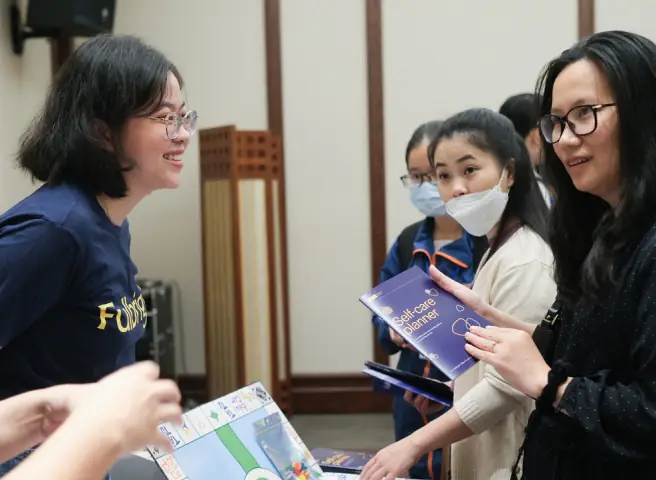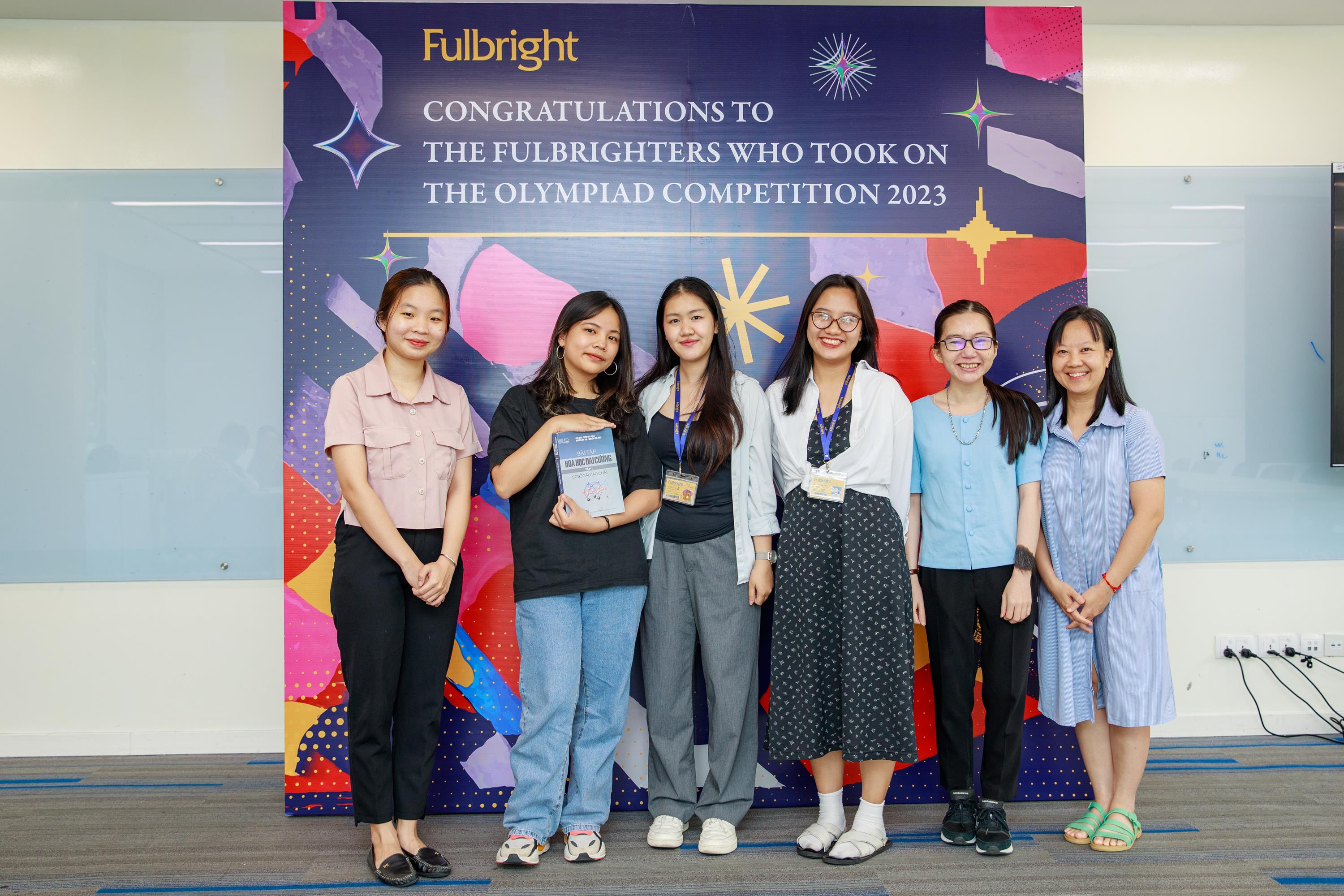
The second panel of the conference titled “Nguyen Du and Contemporaries” recently organized by Fulbright University Vietnam explores the creative approaches of artists, choreographers, and film directors to adapt the literary masterpiece The Tale of Kieu, of illustrious poet Nguyen Du, to a multiplicity of artforms.
The wondrous vitality of The Tale of Kieu can be seen in how often it has been the source of great inspiration for artists, choreographers, and film directors alike, creating numerous works widely acclaimed by the Vietnamese audience.
Under the vast shadow of what is commonly understood as the most significant piece of Vietnamese literature and a major work of the 19th century, art masters strive their hardest to meet their audience’s expectations.
From the literary masterpiece to contemporary forms of art

“Cai luong” singer Bach Tuyet
Panelist Bach Tuyet has been a cải lương singer (loosely translated as reformed theater, or modern South Vietnamese folk opera) for close to 60 years. She is famous for her role in many major cai luong performances over her long career, including “Kim Van Kieu” in which she played the role of Thuy Kieu, the main character of The Tale of Kieu.
One of the biggest milestones of her career was the opening of a private cai luong troupe together with Hung Cuong, a famous male cai luong singer, in 1971. The duo later introduced three cai luong performances based on The Tale of Kieu, all critically acclaimed.
According to Bach Tuyet, that work was only the continuation of other cai luong masters’ attempts to adapt the epic poem to the folk opera form. Back in 1918, the cai luong troupe of Mr. Nam Tu in My Tho, a city in the Mekong Delta region of South Vietnam, introduced Kim Van Kieu, the first cai luong performance based on The Tale of Kieu.
“Why did he pick The Tale of Kieu for adaption? Perhaps it is because there is nothing more suitable than adapting a famous Vietnamese literary work regarded as a symbol of Vietnamese culture into a traditional theatrical form made for the middle class during the country’s French colonial period,” she said at the conference.
For Bach Tuyet, The Tale of Kieu is a highly narrative poem. Nguyen Du was a master in employing the written form to spark the imagination. When adapting a work characterized by the use of words into a form of performance, the hardest part for cai luong directors and actors is to keep the narrative feature of the original work and at the same time underline the dramatic aspects of the theatrical form.
According to panelist Dao Ba Son, directing a movie based on a poem written by Nguyen Du was an excellent experience. In 2010, he directed the film “Long Thành cầm giả ca” (The zither player of Thang Long) based on the namesake poem about a musically gifted girl in Thang Long, the former name of Hanoi.

Film director Dao Ba Son
Nguyen Du wrote the poem in 1813-1814, as he travelled to China as an ambassador under King Gia Long. He stopped by Thang Long and saw a once-famous zither player and singer, now saddened, tired and old among young and beautiful singers. But this was not his first meeting. He remembered seeing the woman 20 years prior, as a young, beautiful, and greatly admired talent.
Based on the poem, screenwriter Van Le developed a story centered on the tragic love between Nguyen Du and the zither player named Cam; the movie also portrayed the life of Vietnamese people during the 1783-1813 period – one of the most chaotic times in Vietnamese history that saw the change from the Le to the Nguyen Dynasty.
The movie was screened at cinemas nationwide, coinciding with the opening of Hanoi’s millennial anniversary in October 2010. The script was awarded first prize from nearly ten historical films shown during the event.
For Dao Ba Son, the film addresses the immortality of art through the suffering of intellectuals like Nguyen Du and fragile artists such as Cam. They have the same talent, the same love for art, the same fate, the same pains about themselves and the life. “The rulers have changed, people have aged and died but the values of art will live forever,” he said.
Targeting the young audience

Film director, actress Mai Thu Huyen
Widely known as an actress, Mai Thu Huyen took her fans by surprise when she announced her role as the director and producer of a new film project in late September 2020: the latest adaptation for the big screen of The Tale of Kieu, minimally titled “Kieu”.
Huyen shared that this project was 10 years in a making, and was slated to be completed this year, on the occasion of Nguyen Du’s 200th death anniversary.
This project brought her on a deeply convoluted journey full of difficulties and challenges. The past decade saw her knock on the doors of many Kieu researchers, writers, and screenwriters to develop a suitable screenplay for “Kieu”. Yet many were reluctant to accept her offer. Indeed, some said they felt huge pressure adapting a work so influential, with its large audience of dedicated fans. On the other hand, the scripts she did receive did not feel persuasive enough. Huyen was afraid she would have to give up on this ambitious project.
Eventually, film director Phi Tien Son, that she had hired as consultant for her project, was moved by Huyen’s dedication for the project, and took it upon himself to write it. His script won her heart. Soon after, she was calling for investors to start shooting the movie.
“I seized the chance on that movie. To me, this was a now or never opportunity to honor such a great literary work,” she shared at the conference.
After two months of shooting in six provinces across the country, the movie is currently undergoing post-production before hitting the cinemas early next year.
When the pre-teaser of the movie was released in September, a small detail sparked controversy among young netizens. However, Huyen said she was undeterred. This meant young people, the target audience for her film, were paying a lot of attention, both to The Tale of Kieu and her production.
According to Huyen, the movie is not a copied version of the epic poem; it is an attempt to re-invent the work so that it could reach the young audience easier.
“Each form of art has a different kind of expression and a different approach to the audience, so is the movie Kieu. This movie is independent from the original work,” she explained.
Also named Kieu, the ballet produced by Ho Chi Minh City Ballet, Symphony Orchestra and Opera presented in June attracted the attention of the public in Hanoi and HCMC.
“Ballet Kieu”, as it is known, is the second dance performance adapted from The Tale of Kieu; the first was a dance show directed by a Korean, Yoo-Oh Chun. According to choreographer Nguyen Phuc Hung, the producers of Ballet Kieu have long yearned to re-create the image of Kieu on pointe shoes, with the heart and soul of Vietnamese people, for the Vietnamese audience.

Choreographer, ballet dancer Nguyen Phuc Hung
“As a form of art, the lack of words in ballet create unique constraints and challenges to convey the meaning of The Tale of Kieu and stay true to its spirit. It’s about finding a new language to express it in a combination of sights, sounds, and the soul of ballet dancers,” he said.
When it came to choreographing, it was important to combine an expression of the Vietnamese spirit with European ballet techniques, according to Hung.
Hung and another choreographer, Tuyet Minh, gave special attention to the vocabulary of movement of the dancers, striving to bring a different sense to The Tale of Kieu through the body language of dancers. To create a successful modern ballet, they thoroughly blended the techniques of the European tradition with Vietnamese dance, along with musical effects, costumes, props and modern visual arts.
Despite the challenges, Director Dao Ba Son concluded, it was an honor for him to adapt Nguyen Du’s poem into a movie; the great poem always brings to life the most miserable people in society, and those hardest hit by chaos and upheaval.

“I think Nguyen Du is greater than what we think he is. It’s still a long way for us to create something that can truly do justice to his works. When I started directing “The zither-player of Thang Long”, I read a lot of his writings. And I realized everything I know about him is so very little compared to his tremendous influence on our country. But his greatest characteristic is perhaps the way he put human suffering into words. He was always concerned and thoughtful about the people, the times, and himself. I remember this verse in one of his poems: “Chẳng biết ba trăm năm lẻ nữa. Người đời ai khóc Tố Như chăng? (In 300 years, who will cry for To Nhu? (To Nhu is one of Nguyen Du’s pen names),” reflected Son.
Dr. Nguyen Nam, lecturer for the Vietnamese Studies major at Fulbright University Vietnam, further discussed how artistic works such as cai luong performances, a movie, or a choreography based on The Tale of Kieu all constitute different ways to interpret the poem. And in so doing, they help Nguyen Du’s successors to convey the beauty of The Tale of Kieu to a larger audience, making it live forever in Vietnamese people’s hearts.
Thuy Hang







